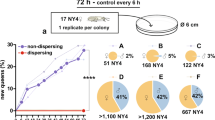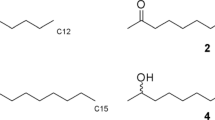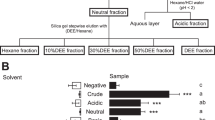Abstract
THE trail-laying capabilities of termites have been known for many years and, quite recently, this activity has been shown1,2 to be based on pheromones produced by the sternal gland. Both primitive and advanced termites possess such a gland, which consists of a rather diffuse structure beneath the fifth abdominal sternite3. In two species, namely Zootermopsis nevadensis (Hagen) (Hodotermitidae)1,2 and Nasutitermes corniger (Mots.) (Termitidae)2, extracts of the appropriate region, or indeed of the whole insects, could be used to lay artificial trails that were readily followed by the parent termites. However, no clear indication of the chemical nature of the pheromones involved has yet been published.
This is a preview of subscription content, access via your institution
Access options
Subscribe to this journal
Receive 51 print issues and online access
$199.00 per year
only $3.90 per issue
Buy this article
- Purchase on Springer Link
- Instant access to full article PDF
Prices may be subject to local taxes which are calculated during checkout
Similar content being viewed by others
References
Lüscher, M., and Müller, B., Naturwissenschaften, 47, 503 (1960).
Stuart, A. M., Physiol. Zool., 36, 39 (1963).
Stuart, A. M., Proc. Zool. Soc. Lond., 143, 43 (1964).
Author information
Authors and Affiliations
Rights and permissions
About this article
Cite this article
MOORE, B. Isolation of the Scent-trail Pheromone of an Australian Termite. Nature 211, 746–747 (1966). https://doi.org/10.1038/211746b0
Issue Date:
DOI: https://doi.org/10.1038/211746b0
This article is cited by
-
Temporal variation in diets and trophic partitioning by coexisting lizards (Ctenotus: Scincidae) in central Australia
Oecologia (1991)
-
Evidence for trail-pheromone precursor in termiteReticulitermes speratus (Kolbe) (Rhinotermitidae: Isoptera)
Journal of Chemical Ecology (1990)
-
Behavioral bioassays of termite trail pheromones
Journal of Chemical Ecology (1985)
Comments
By submitting a comment you agree to abide by our Terms and Community Guidelines. If you find something abusive or that does not comply with our terms or guidelines please flag it as inappropriate.



